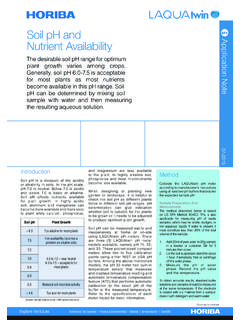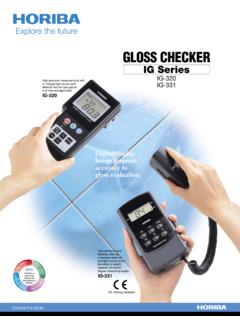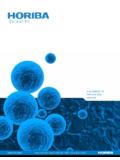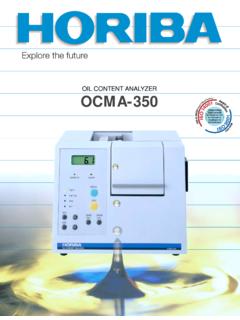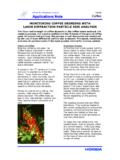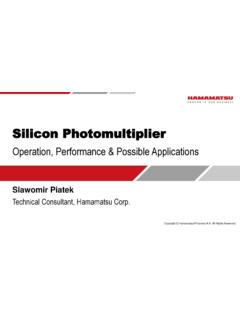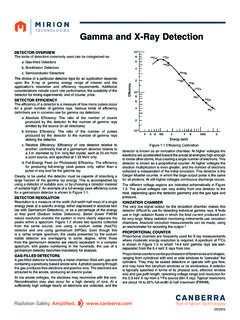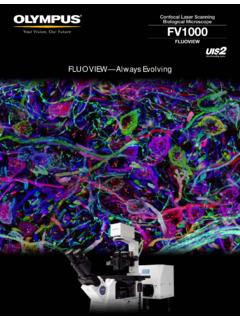Transcription of NaI Scintillation Detector - HORIBA
1 98 English Edition Scintillation DetectorKyoshiro Imagawa[The Development Team (in Japan)]Back row from the left:Hiroshi Ito, Yasuo BabaFront row from the left:Yoshio Yanagida, Kyoshiro Imagawa[The Development Team (overseas)]From the left:Hiroo Chihara ( HORIBA Instruments Inc.),Kyoshiro Imagawa ( HORIBA , Ltd.),Manuel Qiros ( HORIBA Instruments Inc.),Dameian Austin ( HORIBA Instruments Inc.),Ahmed Abulfotuh ( HORIBA Instruments Inc.),Takeshi Yamada ( HORIBA Instruments Inc.),Monica Henson ( HORIBA Instruments Inc.),Steve Bower ( HORIBA Instruments Inc.) HORIBA started manufacturing infrared optical crystals in 1954. In the following year, development of thescintillation Detector began. This Detector , in which Sodium Iodide (NaI) was used, was used for radiationmeasurements.
2 The infrared optical crystal is a principal part of the technology on which infrared gasanalyzers are based. Gas analyzers are the company s prime products. But on the other hand, the growingof large-sized crystals has also become very successful. We grow some of the largest Sodium Iodidecrystals in the World. So here we introduce crystal growth, manufacture of the Scintillation Detector andgamma plate, as examples of applications related to Scintillation detectors for radiation measurementsthat have been built on the foundation of HORIBA s radiation 1948, it was reported that there was a large scintillationphenomenon caused by adding a trace quantity of Thallium(Tl) into a crystal of Sodium Iodide (NaI). HORIBA startedmanufacturing and development of the NaI (Tl) crystalshortly after NaI (Tl) was discovered.
3 The development ofthe NaI (Tl) plate for gamma cameras started in the the beginning, crystals with diameters of 1 inch to 3 incheswere used as detectors for nuclear physics experiments,environmental radiation measurements at nuclear powerplants, or radioimmunoassay. Additionally, mosaic-typecrystals were also developed to correspond to large-sizedcrystals in addition to the crystals with a diameter ofapproximately 5 inches. After the large-sized gamma camerawas developed, larger and larger crystals have beendemanded every year, and we have been trying very hard toget ever larger sized NaI (Tl) crystals in recent Technical ReportsNaI (Tl) CrystalThe development of the NaI (Tl) crystal for gamma camerasgoes back 40 years.
4 Currently, crystals with a diameter of5 inches to 30 inches are in commercial use. HORIBA alsosucceeded in manufacturing a large-sized crystal with adiameter of 31 inches and a weight of 500 kg, and hasentered into the market (Figure 1). Figure 2 shows Arizonafactory where Sodium Iodide crystals are 1 Crystal with a Diameter of 31 Inches (787 mm) anda Weight of 1100 lbs (500 kg)Figure 2 Arizona Factory where Sodium Iodide Crystals areManufacturedFurthermore, new crystals, NaI (Tl), Csl (Tl), and recentlyBi4Ge3O12 are being developed according to requirements,but NaI (Tl) is still predominant as nothing exceeds NaI(Tl) with respect to 1 shows the performance of a typical crystal for ascintillation 1 Performance of a Typical Crystal for a Scintillation DetectorMaterialNal(TI)Csl(TI)Bi4Ge3O12 Density (g/cm3) constant (ns)2301000300 Luminescence420565480wavelength (nm)Relative light intensity100457-10 Refractive of NaI (Tl)After the NaI (Tl)
5 Crystal was developed in 1948, thedevelopment of the gamma plate has been active since around1970s. For the past 30 years, enlarging crystals has been themain challenge, mainly in connection with enlargement ofthe gamma plate. The NaI (Tl) crystal is manufactured bythe Bridgeman-Stockbarger method also known as thepulling-down method in the same manner for other alkalihalides such as NaCl. This method is to fill a crucible withthe particulate raw materials and melt them at a hightemperature, then to gradually solidify the melt by slowlylowering it into the cooling section. Figure 3 is a diagram ofthe manufacturing principle, and Figure 4 shows theappearance of the sectionCooling sectionHeat insulation materialHeaterBaffleHeaterCrystalMelting Vacuum pumpFigure 3 Diagram of the Manufacturing PrincipleFigure 4 The FurnaceNaI Scintillation Detector100 English Edition are particulate materials of a grade suitable forcompounded scintillations.
6 Especially, 40K as it exists innature is manufactured, paying special attention to keep itno more than 2 ppm to distinguish from background Iodide has a remarkable deliquescent property;therefore, it must be stored in completely dry , a crucible is carefully filled with the prepared rawmaterials, and a trace quantity of Thallium, which is anactivator of the Scintillation phenomenon, is added. Thecrucible is placed in the crystal growing furnace, and firstlyvacuum drying and dewatering are performed. Because ofthe deliquescent property of Sodium Iodide, this process isvery important for determining the crystal s optical next process is the temperature raising process wherethe furnace is heated to approximately 700 C to fully meltthe materials in the crucible.
7 Using a lift, the crucible isslowly lowered to the lower (cooling) section of the furnacewhere it solidifies from the tip of the crucible so as tocrystallize the whole. This is the most important process,which requires prudent temperature management technology,as well as a processing period of at least 30 created ingot has a large heat capacity (mass: 240 kg to500 kg), and it becomes a crystal ingot after a further monthof to Function as aRadiation DetectorTo improve the Scintillation performance, (mole ratio) of Thallium (Tl) is added to the NaI crystalas an activator. The mechanism is that electrons created bythe gamma ( ) rays that enter the NaI crystal are caught bythe ionized activator, and the light is emitted at the transitionof the excited state.
8 In the case of NaI (Tl), the conversionefficiency of the gamma rays is thought to be approximately13%, and the wavelength of the light at this point is 420 light is too feeble and cannot be processed as a signalas it is, therefore the light emitted from this Detector iscollected by a photomultiplier to measure the radiationintensity by counting pulses. Figure 5 shows a typicalscintillation Detector , and Figure 6 shows the spectrum 5 Typical Scintillation DetectorFigure 6 Spectrum DataGamma PlateGiven that radioactive nuclides and their compounds wheninjected into the body, gather into cancer cells etc., thegamma plate detects the radioactivity ( rays) emitted fromthose parts. The physicist Anger designed the gammacamera using this principle in the 1950s, and it is thereforecalled an Anger camera.
9 Radioactive medication gathers intospecific internal organs or specific cells, and the gammarays emitted from these parts are detected and then imageprocessing is performed. Therefore, not only abnormal partscan be detected, but also transient conditions can be observedsuch as cerebral blood flow or the motion of the gamma camera components consist of a radioactivemedication that emits gamma rays, a collimator, scintillationdetector, photomultiplier , and signal-processing circuit(Figure 7).101 Technical ReportsLead collimatorRadiation sourceNaI Scintillation detectorPhotomultiplierFigure 7 Configuration of Gamma CameraIn the signal-processing section, the generated positions ofthe output signals from each photomultiplier are calculatedaccording to the strength of the signals, and the image isprocessed based on the calculated data to provide of the Gamma PlateThe gamma plates manufactured and used now are large.
10 From a diameter of 220 mm and thickness of 8 mm, up to500 mm 600 mm and thickness of mm or 25 8 shows an example of a gamma 8 Example of Gamma Plate (480 mm x 550 mm x mm)The manufacturing processes of the gamma plate is asfollows:Mechanical processing is by cutting the NaI ingot,processing the form, then grinding and polishing the follows by enclosing the NaI plate in a case, andso the gamma plate is these processes are performed in a dry room wherehumidity is adjusted to the low humidity or dew point of-30 C or less because the NaI crystal material is deliquescent(Figure 9).Figure 9 Work in the Humidity-adjusted Dry RoomJIS or NEMA standards precisely specify the basiccapabilities of the gamma plate. Not only (with 57Co)or less of the energy resolution as a requirement specific tothe crystal manufacturer but also in surface uniformity,spatial resolution, etc.

